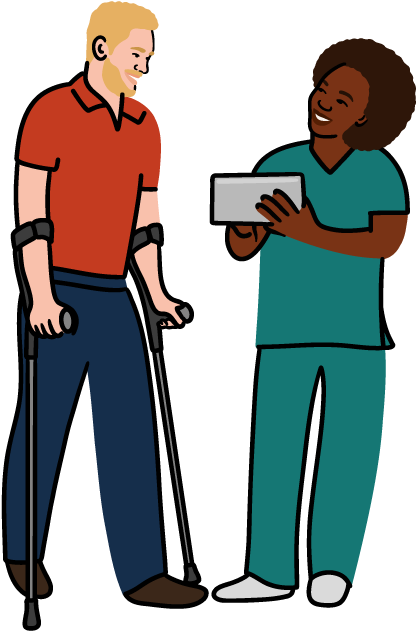Resources
IDD Health Outcomes that Matter: Community-Led Standards for Improvement
A consensus health outcomes framework (a way to organize needed changes in healthcare) to ensure the needs and preferences of people with IDD are prioritized.
About the Framework
The US lacks an approach for setting health priorities for people with intellectual and/or developmental disabilities (IDD) and supporting efforts to measure, improve, and hold clinical organizations and healthcare professionals, payers, and policymakers accountable for the well-being of the IDD population.
Understanding which health outcomes matter most to people with IDD and their care partners/givers serves as the first, essential step toward creating more effective insurance benefits; financing and payment for services; empowering the healthcare workforce to have accountability for priority outcomes; and developing tailored care models for people with IDDs.
Throughout 2022 and 2023, IIDDEAL (Individuals with IDD Engaged, Aligned, and Leading) project convened more than 180 contributors, including people with IDD, care partners/givers, clinicians, researchers, payers, and regulators to discover what health and life outcomes should be prioritized and how healthcare leaders can best support those outcomes.

Read about IDD Health Outcomes that Matter: Community-Led Standards for Improvement as published in the Journal of the American Medical Association.
National Goals for 2035
The IDD Health Outcomes that Matter framework outlines 43 ambitious National Goals to achieve by 2035.
The goals address three major areas for improvement to disrupt current practices in: data collection and quality measurement, coverage and payment for services, and development of the clinical workforce and shared infrastructure. Some goals apply to multiple policy areas but were grouped based on the outcome domain or element that motivated the goal.
National Goals for Improving Data Collection and Quality Measurement:
- Build methods to measure all outcomes that matter by making sure (a) structured data on disability status is standard and consistently included in health care records and claims; and (b) by finding and adapting existing metrics that align to outcomes that matter; and 3) by creating new metrics to fill gaps.
- Major patient experience surveys will include questions on:
- Whether a person/family got all the information they need about pros and cons of different options to make decisions;
- Whether they feel supported by the care team in having choices through shared or supported decision-making;
- Whether they were able to exercise shared or supported decision-making;
- Whether the care team asked the person/family about what is most important to them;
- Whether the person/family felt that the care team did the best they could to honor their wishes;
- Whether the person/family felt that the care team took their concerns and opinions seriously.
- Major patient and caregiver/partner surveys will define care coordination and include questions on:
- Whether a person or caregiver/partner feels their care was well coordinated;
- Whether a person that transitions from one care setting to another feels care teams were aligned;
- Whether a person or caregiver/partner has a bad outcome because of poor coordination.
- The major patient experience surveys include questions on whether patients feel their healthcare provider:
- Treated them with respect and presumed ability;
- Provided accommodations and used preferred forms of communication;
- Honored their goals;
- Made them feel welcome.
- Payers and regulators are consistently measuring elements of strong primary care, including person-centered primary care; continuity (relationship over time); comprehensiveness (able to provide most of what a patient needs in one place); and trust.
- All healthcare plans are required to report data on the implementation of person-centered outcome measures – reported at health-plan level with national benchmarks.
- People with IDD and their care partners/givers will reach consensus on a definition of social drivers of health that is reflective of their community and set standards for collecting related data in electronic health records (EHRs).
- EHRs will add ways to routinely capture information on:
- How a person with IDD or support team signals a change in pain or energy;
- Pain and energy assessments based on new standard scales and/or comprehensive evaluation to identify physical causes;
- Tailored guidance for clinical teams to give individual patients with IDD and their care partners/givers about when to alert the clinical team about changes in pain and energy.
- A new national standard for EHR is established and the three largest EHR companies will include a question in the person’s medical record for answers to the question, “Are you a caregiver?” and capture a range of types of caregiving, such as whether respite care is required.
- 75% of care partners/givers will have an identified respite care plan as part of the longterm care plan or complex care plan in the EHR of their person with IDD.
- A new national standard for EHRs is established and implemented by the three largest EHR companies to include a new structured field to capture patient’s broad goals and what they would like to be accomplished in the encounter. Alternatively, more consistent use of existing “goals” fields in EHRs would capture longer-term priorities than “reason for visit” fields.
- At the point of transition to adult care providers (eg, ages 14-26 y), 50% of people with IDD and their caregiver/partners will document steps they are taking and preferences in their health record related to: connecting with services, services needed or wanted, other family members involved in care, and crisis/emergency plan. This plan should be reviewed at a minimum every five years.
National Goals for Improving Coverage and Payment for Services on Priority Outcomes:
- Medicaid in all states will expand dental coverage for adults with IDD or other disabilities to include extensive coverage, inclusive of more frequent preventive visits, interventions, and payment for longer visits.
- Public and private health insurance companies offer new or enhanced benefits for children and adults with IDD or other disabilities, inclusive of health, vision, and dental coverage (eg, more frequent preventive visits and payment for visits that last more than one hour).
- In the next five years, IDD advocates will identify at least two policy levers (eg, mental health parity laws, designations of underserved populations; law enforcement policies) to make integrated mental/physical care available to and effective for people with IDD.
- Centers for Medicare & Medicaid Services (CMS) funds 1,115 waivers for housing benefits via short-term Medicaid rent assistance in at least 10 states that support people experiencing food insecurity, housing insecurity, or people who are economically and medically vulnerable.
- Medicare, Medicaid in 25 states, and the three largest insurers provide coverage for technology tools to enhance safety and health in the home.
- Medicare, Medicaid in 25 states, and the three largest insurers offer healthcare professionals extra payments to address personalized social drivers of health.
- CMS or five states conduct a demonstration project in Medicare and/or Medicaid that incorporates individualized health and well-being life plans to address social drivers of health.
- 100% of individuals with IDD who have experienced sexual assault or trauma, regardless of disability, are supported and provided accommodations to access all appropriate mental health and other services.
- Medicare, Medicaid, and the three largest insurers will provide universal coverage for sexual assault treatment, including reproductive, physical/dental, and mental health sequelae to people with IDD.
- Medicare, Medicaid in 25 States, and the three largest private insurers all include people with IDD on advisory councils, workgroups, and other stakeholder meetings, and support them to meaningfully lead or co-lead the design of payer’s programs and policies serving people with IDD.
- To enhance payment on the actual experience of care, the major patient experience surveys must include design, outreach, and analytic elements that make the surveys meaningfully accessible to, and private for, people with IDD (eg, people who use assistive devices, AAC, Plain Language, use of graphics and illustrations, audio, etc.).
- Medicare, Medicaid in 25 states, and the three largest insurers will offer coverage for co-location of key services (eg, mental health imbedded into primary care; dental and primary care).
- Medicare, Medicaid in 25 states, and the three largest insurers will offer coverage for an independent system navigator imbedded into the care setting, addressing needs across medical and community sectors, and across different lifespan transitions.
- Medicare, Medicaid in 25 States, and the three largest private insurers offer higher payment to clinicians to have longer visits with people with IDD, which may be inclusive of spending time with care partners/givers when they attend visits.
- Federal agencies or other national organizations, in collaboration with community members, will develop a framework for an online, searchable database with community resources organized by areas of need, including emergency services.
National Goals for Improving the Clinical Workforce and Building Shared Infrastructure:
- The federal government designates people with IDD as a medically underserved population and offers incentives for clinicians to serve this community.
- At least 25 states require a certification/continuing education program for primary care and mental health professionals on how to serve people with IDD with co-occurring mental health and substance use disorders based on their preferred way of receiving help, emphasizing the value of self-determination.
- Twenty-five states identify resources for and support the development of a qualified workforce through the implementation of a psychiatric/mental health consultation or co-location model, especially for primary care professionals (eg, ECHO model).
- General principles of accessible, empowering, non-stigmatizing, and trauma-informed care are integrated into training curricula for healthcare and other service professionals, including via direct experience with people with IDD and care partners/givers.
- Create an incentive-based clinician certification on person-centeredness, respect for persons, and presumption of ability/assent/consent that rewards clinicians for investing in learning how to support these concepts in practice.
- The accrediting and licensing boards in all healthcare professions will include IDD content across the lifespan in at least 10% of competency requirements, some of which may be IDD-focused, and some which may address common conditions that people with IDD have, in the learning continuum from training into practice.
- Health professional students and trainees in all pre-licensure programs will receive mandatory training in areas of importance to people with IDD and care partners/givers through existing models that partner with community experts as part of the training teams and interactive patient training experiences with people with IDD, and practice using tools that support better care for people with IDD (eg, AAC devices, telehealth).
- Increase 10-fold the number of healthcare and dental practitioners who have IDD.
- 50% of primary care clinicians and reproductive health clinicians routinely screen and provide developmentally appropriate resources and/or education about basic sexual, reproductive, gender, and parenting support across the lifespan to people with IDD.
- 100% of public high-school youth with IDD are required as non-disabled students to be included in the standard health curriculum.
- Each state establishes and maintains a directory of in-person and/or online self advocate peer support groups that qualify to receive payment by payers and regulators, including in rural and urban areas. Directories are accelerated through state-to-state learning networks.
- Development of a technology solution to address data sharing across sectors of care including but not limited to educational, medical, dental, and community care for promoting continuity and coordination of services.
- Identify five key outcomes from this framework that community members say have the biggest gap in effective interventions and make investments to develop new interventions as solutions. The size of investments should be proportionate to the size of the need to people with IDD, families, payers, clinicians/providers due to the gaps. Interventions and tools should be developed in partnership with people with IDD, families, universities, payers, clinicians/providers, and government, and leverage crowdsourced platforms that include personal experiences.
- Creation of centralized, accessible databases that house information on the value/return on investment (ROI) of different payment approaches, care models/services (eg, comprehensive primary care models), and interventions/tools. Value/ROI may be defined differently for each stakeholder group.
- Production of at least 30 national press stories, television shows, movies, national social media campaigns, advertisements by national companies, foster/adoptive agencies, and/or other major media releases that positively demonstrate people with IDD as parents, and promote influencers with IDD.
- Expansion of existing curricula on parenting for people with IDD by a coalition that includes public agencies, community members that include peer mentors who are IDD parents, providers of birthing services, and community-based organizations. The enhanced curriculum is implemented by at least 25% of all birthing centers, hospitals, pregnancy-care practices, independent professionals who support birthing, and state agencies that offer parenting resources.
National Goals Public Comment Period: Open through September 30, 2024
We value our community’s input. Please submit your comments, suggestions, or questions using the form below. All comments received by September 30, 2024, will be reviewed and considered. We will summarize and respond to common themes across the comments received.
Share Your Feedback
COMING SOON: HEALTH OUTCOME DOMAINS AND PRIORITY ELEMENTS
We will be sharing the nine Health Outcome Domains and 29 Priority Elements outlined in the Framework later in 2024.
Critical Next Steps
For Improving Data Collection and Quality Measurement:
- Building a standardized dataset on people with IDD.
- Creating data tools to better identify people with IDD.
- Building coalitions of diverse patient advocacy groups (eg, people with IDD, those who are frail and/or elderly, patients with cancer, ideally of diverse races and cultures) that would benefit from new metrics to advocate for a focused commitment from government and others for funding and policy alignment.
- Reviewing currently available quality performance measures to identify gaps.
- Defining the testing needed to develop and validate new measures.
- Engaging other key policymakers and partners, including the Office of the National Coordinator on Health Information Technology.
- Creating a roadmap for holding healthcare organizations accountable for outcomes (such as financial incentives or public reporting) once measures are available.
For Improving Coverage and Payment for Services:
- Federal designation of people with IDD as a medically underserved population to increase access to health care professionals and steer greater resources to clinical organizations serving this population.
- Payment for community-based organizations to become routine members of health care teams.
- Incentives for health care professionals and clinical organizations to close referral loops (getting people with IDD through the “last mile” from referrals to receiving social or other services they need).
- Eliminating wait lists for Home and Community Based Services (HCBS) and other Medicaid-funded IDD services, and/or making sure that people with the most urgent needs get access first.
- Reducing the administrative burden on clinical organizations and health care professionals so they can focus on care relationships and solving problems.
- Ensuring a safety net of services and support for when care partners/givers age or die.
For Improving the Clinical Workforce and Building Shared Infrastructure:
- Developing and implementing campaigns targeting clinicians in practice and those in training to drive culture change through acquisition of basic skills in serving people with IDD.
- Finalizing a national data definition of IDD for consistent application in research, clinical care, and financing/payment policies.
- Investment in centralized data sources on people with IDD.
- Engagement with the IDD community, technology developers, and other healthcare actors to identify key gaps in care where new technology solutions could be most valuable and effective.
Framework Highlights
2024
In August, the Framework is featured the Journal of the American Medical Association in an article titled:
Advancing Health Policy and Outcomes For People With Intellectual And/Or Developmental Disabilities: A Community-Led Agenda
- Explore
Video: National Roadmap Explainer
This video provides a brief overview of why a National Roadmap is necessary and previews the clear goals and commonsense actions it sets out to achieve.
Webinar: Using the National Roadmap for Action
IEC hosts a webinar with clinician and self-advocate steering group members on putting the National Roadmap into action.




